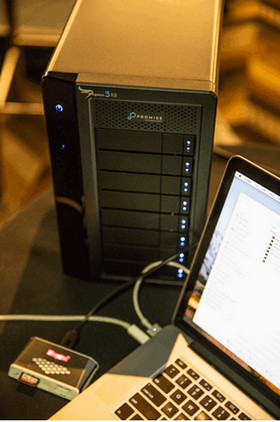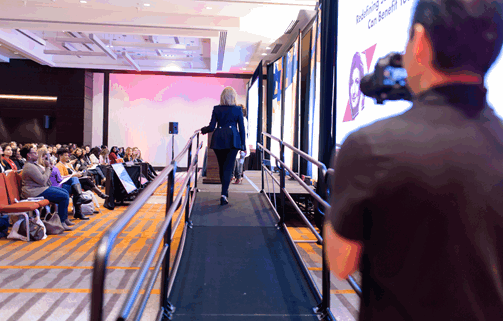
Corporate Videography Challenge | Promise Pegasus3 R8
Written by Alex Win, Owner/Filmmaker at Alex Win Studios
My studio, Alex Win Studios, recently covered Women of Silicon Valley, a two-day technology conference in San Francisco promoting gender equality and inclusion. In total, we recorded 34 presentations across two main tracks, and captured 19 interviews of speakers and participants. Over 800 high-tech attendees from around the world attended the conference.
This was, no doubt, the largest corporate event that we have been hired to cover, and to be honest, a lot of things ran through my mind in preparation for the shoot – one of which was how we would manage storage and backup of recordings during the event.
As a background, an event like this would typically be shot in HD (1080p). Data rate for 1080p is roughly 90 mbps (megabits per second) using our video cameras. Translated to disk usage terms, that would be equivalent to about 40 GB (gigabytes) per hour per camera. With 5 hours of presentations per track, with 4 cameras, that amounts to 800 GB of storage. Realistically, I would have no problem having these footages backed up throughout the day onto our USB drive, while keeping our data intact on the primary memory cards until I got back to the office and backed up the footages onto secondary and tertiary drives. Once everything is satisfactorily backed up in multiple places, I would format the cards for the second day of shooting.
However, what made this shoot a challenge was that everything was to be shot in 4K!
What that meant storage-wise on our cameras was instead of a data rate of 90 mbps, we’re faced with 525 mbps. To translate, a large 512 GB memory card would last us merely 2 hours of recording per camera. This amounts to over 4 TB of data per day with the 4 cameras!
 The 512 GB memory cards we needed unfortunately don’t come cheap, so I rented them – 2 per camera for a total of 8 of them! Keep in mind, there are not too many places that rent cards this large. The idea was to back up a card while another card was recording, format it once complete, and repeat with the next card. Initially, I thought of utilizing an 8 TB USB disk, and constantly backing up that disk to another 8 TB disk. But the thought of having a hired Digital Tech doing that mistake-free gave me the shudder, not to mention that the single-spindle USB drives would likely not be fast enough to digest multiple cards in parallel.
The 512 GB memory cards we needed unfortunately don’t come cheap, so I rented them – 2 per camera for a total of 8 of them! Keep in mind, there are not too many places that rent cards this large. The idea was to back up a card while another card was recording, format it once complete, and repeat with the next card. Initially, I thought of utilizing an 8 TB USB disk, and constantly backing up that disk to another 8 TB disk. But the thought of having a hired Digital Tech doing that mistake-free gave me the shudder, not to mention that the single-spindle USB drives would likely not be fast enough to digest multiple cards in parallel.
As I contemplated RAID devices, I wanted something that was fast, reliable, and proven. There were quite a number of budget solutions out there, but doing this job well meant more future jobs like this, and this wasn’t a time to go the cheap route. There was only enough time to backup footages once, and failure wasn’t an option, especially for an event like this.
I inquired with my contact at Promise Technology (I was previously in Tech), and I was recommended their Pegasus3 R8, a direct-attach Thunderbolt 3 8-bay RAID 5 storage system, with a protected capacity of 42 TB. I was told I could borrow one for the event (!!), so I drove to their office in Silicon Valley the following day and picked it up.
I put it through its paces, making sure the array was fast enough to handle multiple memory card backups in parallel -- sure enough, it did without breaking a sweat. I ran some additional benchmarks just to make sure, and it showed it was handling sequential writes at well over a gigabyte per second even through my slower Thunderbolt 2 interface of my MacBook Pro laptop.
The proof was in the pudding, andneedless to say, the two-day coverage went without a hitch. In all, we captured over 7 TB of 4K footages. Everything went according to plan, and other than carrying the heavy R8 carefully back and forth, it performed flawlessly.

The day after the conference, the 4K footages were digested into Final Cut Pro X for editing straight off the R8. Typically, I edit off a 1TB SSD drive, but to edit 7 TB of video would have at the very least be a pain, having to shuffle files in and out to fit within the edit drive. It made perfect sense to just edit the 4K footages off the R8 -- the bonus being that because the RAID is so fast, there’s no need to create proxies for editing – creating proxies is a slow and tedious process and the proxies take up more unnecessary storage in the process.
 To be able to edit true 4K multi-cam footages off the Promise3 R8 with no dropped frames was just beautiful. I really couldn’t be happier with the whole process – from providing peace of mind during the event, to the speed at which it does this, and lastly in how efficient it has made my editing – really phenomenal. I would consider this a must-have for professional videographers, especially ones moving to 4K or even higher.
To be able to edit true 4K multi-cam footages off the Promise3 R8 with no dropped frames was just beautiful. I really couldn’t be happier with the whole process – from providing peace of mind during the event, to the speed at which it does this, and lastly in how efficient it has made my editing – really phenomenal. I would consider this a must-have for professional videographers, especially ones moving to 4K or even higher.
Download Full Story